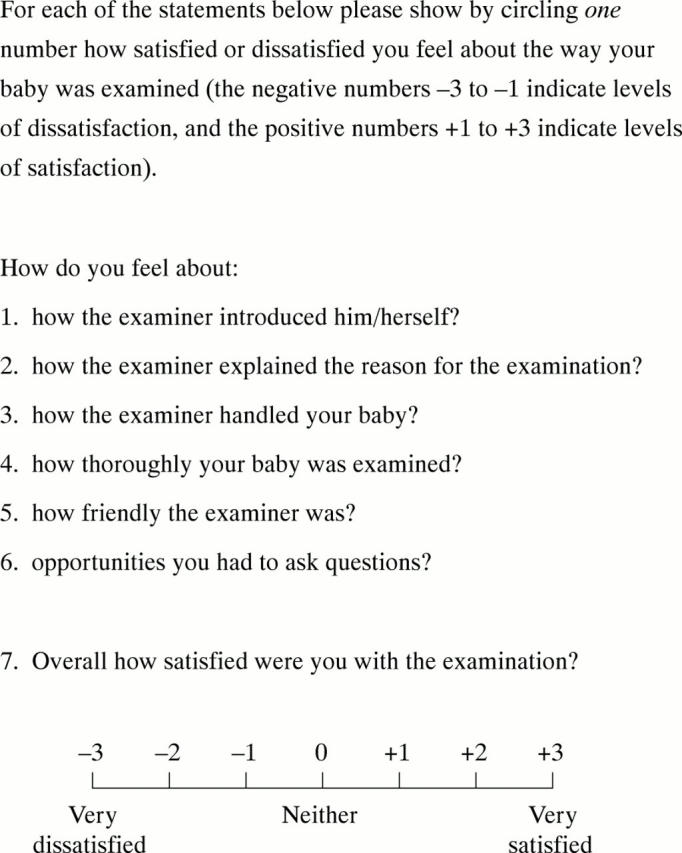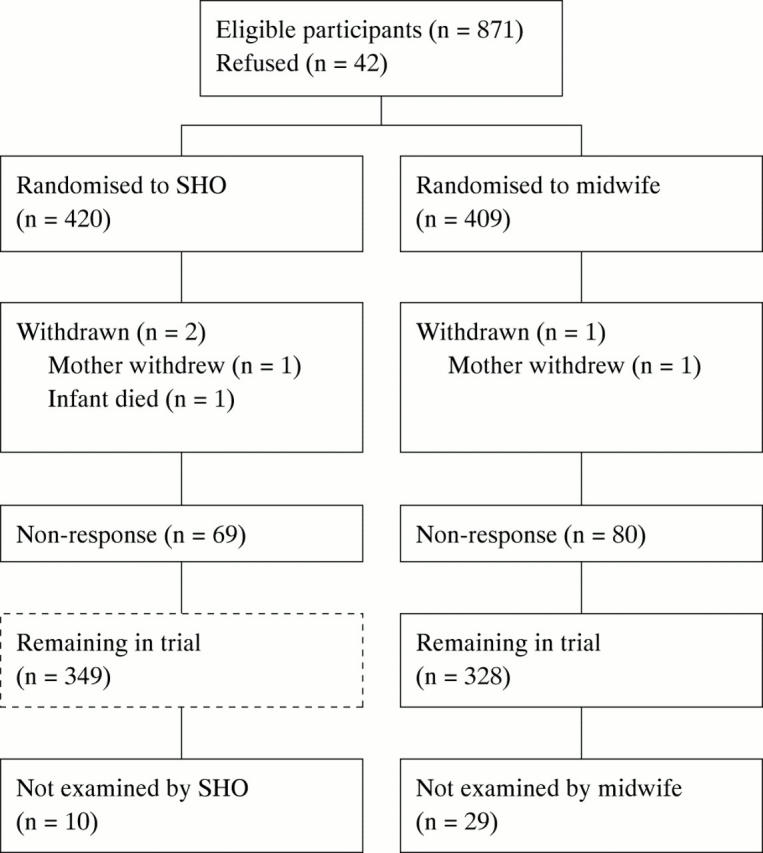Abstract
Objective: To determine whether the routine examination of the newborn by a midwife compared with a junior paediatrician (SHO) affects maternal satisfaction with this examination.
Methods: Randomised controlled trial: 826 mother and baby pairs in a district general hospital in south east England were randomised to a paediatric SHO or a midwife for the routine newborn examination. Maternal satisfaction with the examination was analysed in relation to intervention group, process, and background variables.
Results: Some 81% of mothers reported that they were satisfied or very satisfied with the newborn examination. Mothers assigned to a midwife were more satisfied with the newborn examination (crude odds ratio (OR) 0.54 (95% confidence interval (CI) 0.39 to 0.75), p < 0.001). However, after provision of health education during the examination, continuity of care provided, and history of miscarriage had been controlled for, status of examiner was no longer related to maternal satisfaction (adjusted OR 0.82 (95% CI 0.57–1.20), NS). The discussion of healthcare issues by the examiner (adjusted OR 0.49 (95% CI 0.34 to 0.70), p < 0.001) and continuity of care (adjusted OR 0.43 (95% CI 0.23 to 0.81), p < 0.01) were both related to enhanced satisfaction, and history of miscarriage (adjusted OR 1.61 (1.08 to 2.40), p < 0.05) was associated with lower maternal satisfaction with the newborn examination. Midwives (61%) were more likely than SHOs (33%) to discuss healthcare issues, such as feeding, sleeping, and skin care.
Conclusions: Mothers were more likely to be satisfied with the newborn examination by a midwife than an SHO because midwives were more likely to discuss healthcare issues during the examination and were able to provide continuity of care. However, midwife examinations according to exclusion criteria agreed with trial midwives excluded half of all newborns, and criteria may have to be reconsidered for practice implementation.
Full Text
The Full Text of this article is available as a PDF (125.4 KB).
Figure 1 .

Items on the questionnaire identified as relating to maternal satisfaction.
Figure 2 .

Participant flow through trial.
Selected References
These references are in PubMed. This may not be the complete list of references from this article.
- Ainsworth S., Wyllie J. P., Wren C. Prevalence and clinical significance of cardiac murmurs in neonates. Arch Dis Child Fetal Neonatal Ed. 1999 Jan;80(1):F43–F45. doi: 10.1136/fn.80.1.f43. [DOI] [PMC free article] [PubMed] [Google Scholar]
- Bramadat I. J., Driedger M. Satisfaction with childbirth: theories and methods of measurement. Birth. 1993 Mar;20(1):22–29. doi: 10.1111/j.1523-536x.1993.tb00175.x. [DOI] [PubMed] [Google Scholar]
- Cartlidge P. H. Routine discharge examination of babies: is it necessary? Arch Dis Child. 1992 Dec;67(12):1421–1422. doi: 10.1136/adc.67.12.1421. [DOI] [PMC free article] [PubMed] [Google Scholar]
- Cleary P. D., McNeil B. J. Patient satisfaction as an indicator of quality care. Inquiry. 1988 Spring;25(1):25–36. [PubMed] [Google Scholar]
- Cottrell B. H., Grubbs L. M. Women's satisfaction with couplet care nursing compared to traditional postpartum care with rooming-in. Res Nurs Health. 1994 Dec;17(6):401–409. doi: 10.1002/nur.4770170603. [DOI] [PubMed] [Google Scholar]
- Delbanco T. L. Quality of care through the patient's eyes. BMJ. 1996 Oct 5;313(7061):832–833. doi: 10.1136/bmj.313.7061.832. [DOI] [PMC free article] [PubMed] [Google Scholar]
- Dezateux C., Godward S. A national survey of screening for congenital dislocation of the hip. Arch Dis Child. 1996 May;74(5):445–448. doi: 10.1136/adc.74.5.445. [DOI] [PMC free article] [PubMed] [Google Scholar]
- Glazener C. M., Ramsay C. R., Campbell M. K., Booth P., Duffty P., Lloyd D. J., McDonald A., Reid J. A. Neonatal examination and screening trial (NEST): a randomised, controlled, switchback trial of alternative policies for low risk infants. BMJ. 1999 Mar 6;318(7184):627–631. doi: 10.1136/bmj.318.7184.627. [DOI] [PMC free article] [PubMed] [Google Scholar]
- Hall D. M. The role of the routine neonatal examination. BMJ. 1999 Mar 6;318(7184):619–620. doi: 10.1136/bmj.318.7184.619. [DOI] [PMC free article] [PubMed] [Google Scholar]
- Kenny P., King M. T., Cameron S., Shiell A. Satisfaction with postnatal care--the choice of home or hospital. Midwifery. 1993 Sep;9(3):146–153. doi: 10.1016/0266-6138(93)90021-j. [DOI] [PubMed] [Google Scholar]
- Kerfoot K. M., LeClair C. Building a patient-focused unit: the nurse manager's challenge. Nurs Econ. 1991 Nov-Dec;9(6):441–443. [PubMed] [Google Scholar]
- Klock S. C., Chang G., Hiley A., Hill J. Psychological distress among women with recurrent spontaneous abortion. Psychosomatics. 1997 Sep-Oct;38(5):503–507. doi: 10.1016/S0033-3182(97)71428-2. [DOI] [PubMed] [Google Scholar]
- MacKeith N. Who should examine the 'normal' neonate? Nurs Times. 1995 Apr 5;91(14):34–35. [PubMed] [Google Scholar]
- McKinley R. K., Manku-Scott T., Hastings A. M., French D. P., Baker R. Reliability and validity of a new measure of patient satisfaction with out of hours primary medical care in the United Kingdom: development of a patient questionnaire. BMJ. 1997 Jan 18;314(7075):193–198. doi: 10.1136/bmj.314.7075.193. [DOI] [PMC free article] [PubMed] [Google Scholar]
- Morgan M., Fenwick N., McKenzie C., Wolfe C. D. Quality of midwifery led care: assessing the effects of different models of continuity for women's satisfaction. Qual Health Care. 1998 Jun;7(2):77–82. doi: 10.1136/qshc.7.2.77. [DOI] [PMC free article] [PubMed] [Google Scholar]
- Moss G. D., Cartlidge P. H., Speidel B. D., Chambers T. L. Routine examination in the neonatal period. BMJ. 1991 Apr 13;302(6781):878–879. doi: 10.1136/bmj.302.6781.878. [DOI] [PMC free article] [PubMed] [Google Scholar]
- Proctor S. What determines quality in maternity care? Comparing the perceptions of childbearing women and midwives. Birth. 1998 Jun;25(2):85–93. doi: 10.1046/j.1523-536x.1998.00085.x. [DOI] [PubMed] [Google Scholar]
- Risser N. L. Development of an instrument to measure patient satisfaction with nurses and nursing care in primary care settings. Nurs Res. 1975 Jan-Feb;24(1):45–52. [PubMed] [Google Scholar]
- Salisbury C. Postal survey of patients' satisfaction with a general practice out of hours cooperative. BMJ. 1997 May 31;314(7094):1594–1598. doi: 10.1136/bmj.314.7094.1594. [DOI] [PMC free article] [PubMed] [Google Scholar]
- Spitzer R. B. Meeting consumer expectations. Nurs Adm Q. 1988 Spring;12(3):31–39. doi: 10.1097/00006216-198801230-00006. [DOI] [PubMed] [Google Scholar]
- Séguin L., Therrien R., Champagne F., Larouche D. The components of women's satisfaction with maternity care. Birth. 1989 Sep;16(3):109–113. doi: 10.1111/j.1523-536x.1989.tb00878.x. [DOI] [PubMed] [Google Scholar]
- Triplett R. G., Schow S. R. Surgical advances in implant dentistry. Tex Dent J. 1994 Oct;111(10):12-3, 15-7, 19. [PubMed] [Google Scholar]
- Walker D. Role of the routine neonatal examination. It probably makes more sense for other staff to carry out neonatal examinations. BMJ. 1999 Jun 26;318(7200):1766–1766. doi: 10.1136/bmj.318.7200.1766. [DOI] [PMC free article] [PubMed] [Google Scholar]
- Wardle S. The Mid-Staffordshire survey. Getting consumers' views of maternity services. Prof Care Mother Child. 1994 Aug-Sep;4(6):170–174. [PubMed] [Google Scholar]
- Williams S. J., Calnan M. Key determinants of consumer satisfaction with general practice. Fam Pract. 1991 Sep;8(3):237–242. doi: 10.1093/fampra/8.3.237. [DOI] [PubMed] [Google Scholar]
- Wolke D., Söhne B., Riegel K., Ohrt B., Osterlund K. An epidemiologic longitudinal study of sleeping problems and feeding experience of preterm and term children in southern Finland: comparison with a southern German population sample. J Pediatr. 1998 Aug;133(2):224–231. doi: 10.1016/s0022-3476(98)70224-0. [DOI] [PubMed] [Google Scholar]
- Young D. First class delivery: the importance of asking women what they think about their maternity care. Birth. 1998 Jun;25(2):71–72. doi: 10.1046/j.1523-536x.1998.00071.x. [DOI] [PubMed] [Google Scholar]


